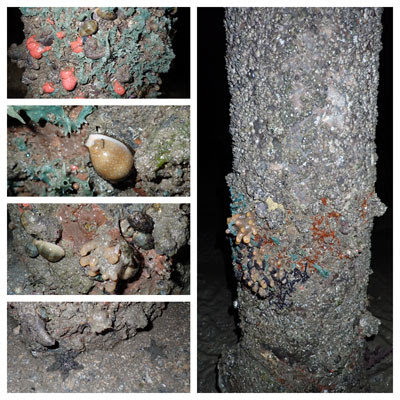We see signs of dugong feeding in the lush seagrass meadows, and lots of juveniles of a rare sea star. The hard corals near the beacon are not mass bleaching, but some seem stressed. There is hardly any sponges and most of the sprinkling of small soft corals were bleaching.
Seagrasses are still growing lush and fresh near the Beacon. Similar to our survey in Jun 2023, I looked and found some furrows that looked like dugong feeding trails. Dugong feeding trails are formed when dugongs chomp up seagrasses including their roots, leaving a shallow meandering furrow of about equal width and depth. Smooth ribbon seagrasses are doing very well growing in a large portion of the area between the boardwalk almost all the way to the beacon, as well as even on the sandbar. Spoon seagrasses grew thick and lush, I saw some Fern seagrass but didn't see any Tape seagrass.
Once again, we spot many small Pentaceraster sea stars! The team first spotted these on Chek Jawa during our evening survey on Dec 23. Previously, these sea stars were only common on Cyrene. It was good to also see some small Biscuit sea stars. Also a Blue feather star, and a sprinkling of common sea cucumbers and sea urchins. The rest of the team saw large Knobbly sea stars.
Thanks to Marcus Ng for taking great photos of some of the many small Pentaceraster sea stars that we saw.
The rest of the team also saw many small Knobbly sea stars, as well as a few very large ones. An small orange Cake sea star was also seen, as well as an orange Crown sea star.
We are expecting our shores to be impacted by global Mass Coral Bleaching in the months ahead. So I paid special attention to the corals near the beacon. I saw about 20 small to medium sized Boulder pore corals. Most were nice and well formed, brown or pale brown but not too pale. One had a lot of white patches, about 5 had many recently dead patches or long dead patches overgrown with seaweed. The tide wasn't really super low today and the wind ruffled up the water so it was difficult to find all the corals and take good photos of them.
The colourful sponge garden we saw in Jun 2023 seems to have disappeared. While there are still a lot of Purple branching sponges, I didn't see any Barrel sponges or many other kinds of sponges. There were still sprinkles of Spiky flowery soft corals among the sponges, these were almost all bleaching.
There remains abundant Haddon's carpet anemones on the sand bar, in the lagoon, everywhere. There were also many Flowery sea pens and some clumps of Posy anemones. I didn't see any that were bleaching.
As usual, the legs of the jetty infront of House No. 1 were colourful with sponges, ascidians, tiny crabs. There were also Crown sea stars and lots of cowries.
One of the special sightings was of a mousedeer! Right at the start, while we were walking through the forest. Thanks to Marcus Ng for the alert and this great photo
What is special about Chek Jawa is that it is one of the few shores that has the spectrum of ecosystems that is needed for healthy shores. A living coastal forest, natural rocky shores, mangroves, seagrass meadows. So it was great to hear the announcement yesterday, that in the South, the coastal forests of Lazarus Island are protected, together with nearby reefs at Kusu Island.
What is the fate of Chek Jawa?
Chek Jawa and Pulau Sekudu is slated for reclamation in the Long-Term Plan Review. The plan includes a road link (black line) from the mainland jumping off at Punggol, crossing to Pulau Ubin through Chek Jawa to jump off to Pulau Tekong before circling back to the mainland on Changi East. Proposed reclamation (in yellow) will bury Pasir Ris shores, Pulau Sekudu and Chek Jawa as well as a large stretches of Changi Beach.
The Singapore Blue Plan 2018
Among the Proposed Areas for Immediate Conservation Priority, the Singapore Blue Plan 2018 proposes that the intertidal and subtidal marine areas of Pulau Ubin to be designated Marine Reserve.
The proposed area would include Tanjung Chek Jawa, the largest known intertidal area in northern Singapore. Considered one of the richest in Singapore, Chek Jawa comprises many adjacent ecosystems: coastal hill forest, mangrove areas, rocky shores, seagrass meadows, coral communities, and sandy areas. Chek Jawa remains an icon of celebration and hope for many Singaporeans since its reprieve from reclamation in 2001.
DOWNLOAD the Plan, SUPPORT the Plan! More on the Singapore Blue Plan 2018 site.
Photos by others on this survey
Richard Kuah
Rachael Goh
Kelvin Yong
Che Cheng Neo
Marcus Ng
Tommy Tan













